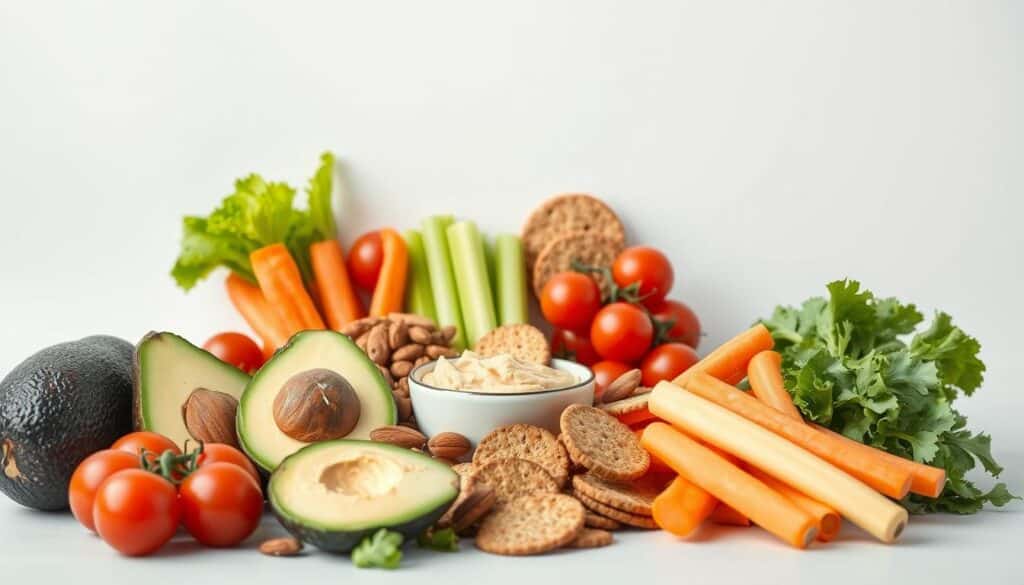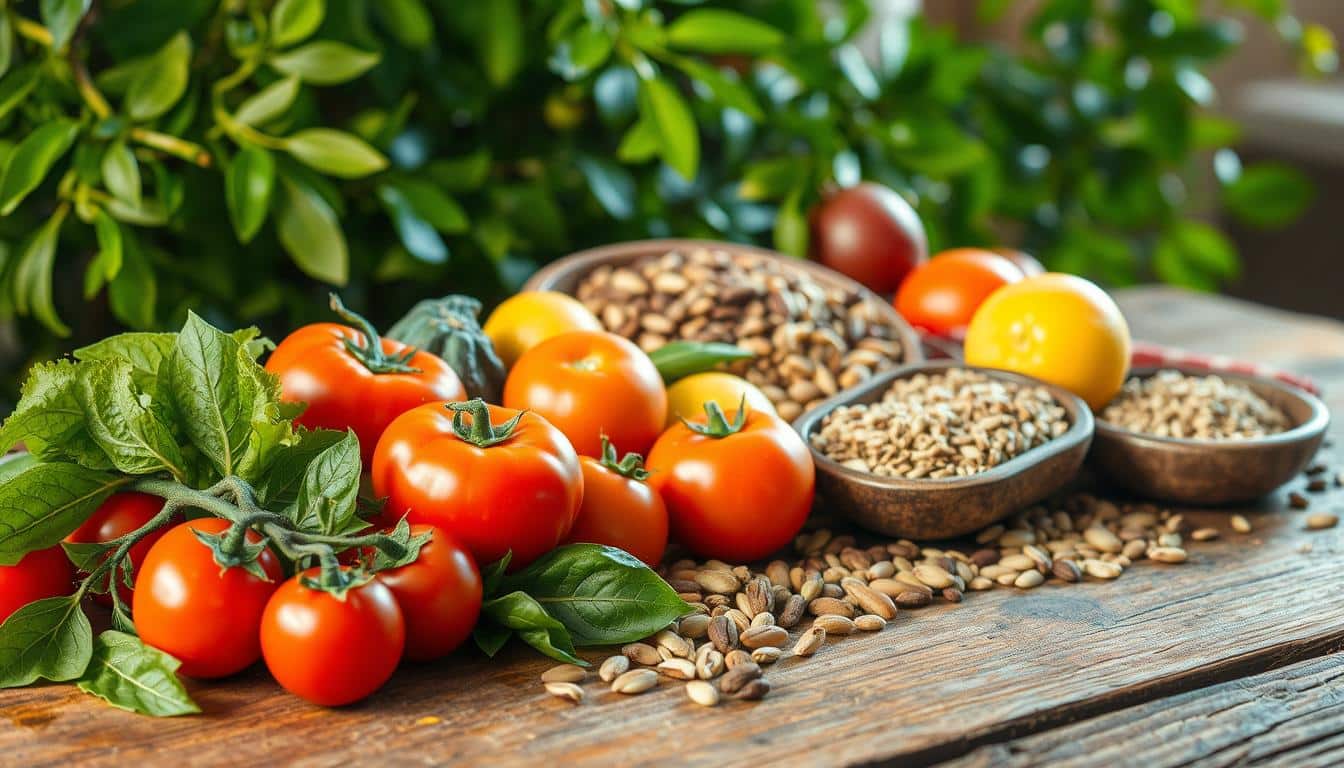Anúncios
Do you want to discover the solution for high blood pressure?
This article promises practical, tasty guidance for managing hypertension through food. You will find a Recipe for High Blood Pressure approach that balances flavor and health. The focus is on lowering sodium while boosting potassium, magnesium, fiber, and healthy fats with heart-healthy recipes you can cook at home.
Anúncios
We base recommendations on evidence-based frameworks such as the DASH dietary pattern promoted by the National Heart, Lung, and Blood Institute and guidance from the American Heart Association. Expect DASH diet recipes alongside low-sodium recipes and meal strategies grounded in science and real-world cooking.

Hibiscus Tea
Readers in the United States who are newly diagnosed, managing stage 1 hypertension, or aiming to reduce medication in consultation with their clinician will find clear, actionable steps. The article includes breakfast, lunch, dinner, and snack ideas, grocery lists, and cooking techniques that preserve nutrients and cut added salt.
Anúncios
The main keyword focus is Recipe for High Blood Pressure, woven naturally into the content to improve search relevance while keeping the writing friendly and useful. Practical tips and heart-healthy recipes will help you build a sustainable high blood pressure diet without sacrificing taste.
Key Takeaways
- Lower sodium and increase potassium, magnesium, fiber, and healthy fats to support blood pressure control.
- Follow evidence-based patterns like DASH for reliable, research-backed results.
- Find easy, flavorful low-sodium recipes you can use for every meal.
- Use shopping lists and simple swaps to make a high blood pressure diet manageable and budget-friendly.
- Work with your healthcare provider when changing diet to support medication or lifestyle goals.
Hibiscus Tea Recipe
Ingredients
- 2 tablespoons dried hibiscus petals
- 4 cups water
- 1–2 tablespoons honey or sugar (optional)
- 1 slice of fresh ginger (optional)
- Fresh mint leaves (optional)
- Ice cubes (for iced tea)
Instructions
- In a medium pot, bring the water to a boil.
- Add the dried hibiscus petals (and ginger if using) to the boiling water.
- Reduce the heat and let it simmer for about 5–10 minutes, depending on how strong you want the flavor.
- Remove from heat and strain the tea into a teapot or pitcher.
- Sweeten with honey or sugar if desired, and stir well.
- Serve hot, or let it cool and pour over ice for a refreshing iced tea.
- Garnish with mint leaves if you like.
Notes
- Hibiscus tea has a naturally tart flavor, similar to cranberry.
- It can be enjoyed both hot and cold.
- For a citrus twist, add a slice of lemon or orange before serving.
Understanding High Blood Pressure and Heart-Healthy Eating
High blood pressure results from a mix of biology, weight, and lifestyle choices. What you eat shapes blood volume, vessel tone, and inflammation. A pattern of whole foods can lower systolic readings by about 5–11 mm Hg, according to consensus guidelines from the American Heart Association and the National Heart, Lung, and Blood Institute.
How diet affects blood pressure
Eating too much sodium raises blood volume and vascular resistance. That forces the heart to work harder. Potassium helps relax vessel walls and supports sodium excretion, a process called natriuresis. Long-term patterns that lead to obesity, insulin resistance, or chronic inflammation also push blood pressure upward.
Key nutrients to focus on: potassium, magnesium, fiber, and healthy fats
Potassium for blood pressure appears in bananas, sweet potatoes, spinach, and beans. These foods counteract sodium and promote healthy excretion.
Magnesium from almonds, pumpkin seeds, whole oats, and leafy greens supports vascular tone and endothelial function.
Fiber from whole grains, legumes, fruits, and vegetables helps blood pressure by improving weight control and metabolic health.
Healthy fats such as extra-virgin olive oil, avocados, walnuts, salmon, and mackerel reduce inflammation and support heart health.
Follow DASH diet nutrients and AHA guidance: aim for balanced targets from food rather than megadosing single supplements. People with kidney disease or on potassium-altering medicines should consult their clinician for personalized targets.
Foods to limit: sodium, processed foods, and added sugars
High sodium intake from processed and restaurant foods raises blood pressure. Most guidelines recommend staying under 2,300 mg daily and aiming for 1,500 mg if you have hypertension.
Processed foods such as cured meats, packaged snacks, canned soups, and many frozen meals hide sodium and unhealthy fats. Reducing these items helps control intake and supports a healthier weight.
Added sugars in sugary drinks and sweets drive weight gain and metabolic risk, which worsen blood pressure over time. Limit sugary beverages and choose whole foods instead.
Consult a clinician before changing potassium for blood pressure if you take ACE inhibitors, ARBs, potassium-sparing diuretics, or have kidney disease.
| Focus | Key Foods | Practical Target |
|---|---|---|
| Potassium | Bananas, sweet potatoes, spinach, beans | Meet daily needs through food; follow DASH diet nutrients guidance |
| Magnesium | Almonds, pumpkin seeds, whole oats, leafy greens | Include a handful of nuts or a serving of whole grains daily |
| Fiber | Whole grains, legumes, fruits, vegetables | Aim for at least 25–30 g per day from whole foods |
| Healthy fats | Olive oil, avocados, walnuts, fatty fish (salmon, mackerel) | Use oils and fatty fish several times weekly |
| Limit | Cured meats, canned soups, packaged snacks, sugary drinks | Target under 2,300 mg sodium; ideal 1,500 mg for many with hypertension |
Recipe for High Blood Pressure
Simple changes in recipes can make meals both satisfying and heart-smart. Below is a practical guide to build blood pressure friendly meals that fit family tastes, cultural preferences, and common allergens while keeping sodium low and nutrients high.
What makes a recipe suitable for blood pressure control
A suitable dish is low in sodium and rich in potassium, magnesium, and fiber. It pairs lean protein or plant-protein with whole grains and plenty of vegetables. Healthy fats like olive oil or avocado should be used in moderation. Portion control matters; aim for balanced servings to support blood pressure goals.
Avoid high-sodium condiments such as regular soy sauce, teriyaki, and bouillon unless you choose low-sodium versions. Rely on fresh herbs, dried spices, and citrus to add bright flavor. Tailor recipes to avoid allergens and respect cultural flavors to improve long-term adherence.
Sample balanced recipe template to customize
Use this DASH recipe template as a modular framework. Start with a base, add protein, load on vegetables, finish with a flavoring element, and include a measured healthy fat.
- Base: 1/2–1 cup cooked whole grain or starchy vegetable such as brown rice, quinoa, or sweet potato.
- Protein: 3–4 oz cooked lean protein or plant-protein like salmon, skinless chicken, beans, or tofu.
- Vegetables: 1–2 cups non-starchy vegetables plus 1 cup leafy greens to reach 2–3 cups total.
- Sauce/Flavor: Fresh herbs, garlic, low-sodium broth, vinegar, or citrus juice to taste.
- Healthy Fat: 1 tablespoon olive oil, 1/4 avocado, or a small sprinkle of nuts or seeds.
Batch cook grains and proteins to speed weekday meals. Swap brown rice for barley or quinoa, replace chickpeas with white beans, and switch salmon for baked cod to vary nutrients and cost.
Tips to reduce sodium without losing flavor
Use fresh herbs like parsley, cilantro, and basil to brighten dishes. Toast whole spices such as cumin and coriander to deepen aroma. Acidic touches—lemon, lime, and vinegars—lift flavor without added salt.
Introduce umami through tomatoes, mushrooms, or a light sprinkle of aged Parmesan. Try nutritional yeast for a savory note in vegetarian dishes. Rinse canned beans thoroughly or choose low-sodium canned varieties to cut hidden salt.
Make homemade low-sodium sauces and dressings using Greek yogurt, tahini, or olive oil emulsions with herbs and citrus. When using reduced-sodium soy sauce or tamari, dilute with water or citrus to keep savory balance while limiting sodium.
Breakfast Ideas to Start the Day Heart-Healthy

Start mornings with simple choices that help blood pressure and boost long-term heart health. A heart-healthy breakfast keeps you full, balances nutrients, and makes it easier to meet daily potassium and fiber goals.
Oat-based breakfasts and their blood pressure benefits
Oats contain soluble fiber called beta-glucan, which helps lower LDL cholesterol and supports cardiovascular health. Using plain, unsweetened oats lets you control added sugars while getting satiety that helps with weight control and blood pressure management.
Try overnight oats made with low-fat milk or fortified soy milk, a tablespoon of chia seeds, fresh berries, and a sprinkle of walnuts for ALA omega-3s. Flavor with cinnamon and fruit instead of sweetened mixes.
Low-sodium, high-potassium smoothie combinations
Choose leafy greens plus banana and frozen mango or berries for potassium, magnesium, fiber, and natural sweetness. Add plain Greek yogurt or unsweetened soy milk and a tablespoon of ground flaxseed for protein and omega-3s.
A quick ratio: 1 cup leafy greens, 1 medium banana, 1 cup frozen fruit, 1/2–1 cup low-sodium liquid base, and 1 tablespoon ground seed or nut butter. Avoid fruit juices, flavored yogurts with added sugars, and packaged smoothie mixes that may contain added sodium.
Whole-grain toast toppings that boost heart health
Pick whole-grain or sprouted-grain breads with minimal added sodium and about 3–4 grams of fiber per slice. Top with mashed avocado, tomato, lemon, and cracked pepper for healthy fats and flavor.
Other ideas include hummus with cucumber and sprouts, ricotta with fresh fruit and a light drizzle of honey, or smoked salmon—choose low-sodium varieties and rinse if needed. Pair toast with a piece of fruit or a small plain yogurt to balance the meal.
These potassium-rich breakfast ideas and low-sodium smoothies blend practicality with proven benefits. Use oats for blood pressure in rotation with whole-grain toast toppings to keep mornings varied and heart-wise.
Lunch Recipes Packed with Potassium and Fiber
Midday meals can support blood pressure and energy when you choose plants, whole grains, and lean protein. Aim for potassium-rich lunch recipes that combine leafy greens, legumes, and starchy vegetables to boost nutrients without excess sodium.
Salads with legumes and leafy greens
Start with a base of spinach, kale, or arugula for potassium and beneficial nitrates. Add 1/2–1 cup cooked chickpeas, lentils, or black beans for fiber and magnesium. Top with roasted sweet potato cubes or beets, cherry tomatoes, pumpkin seeds, and a handful of fresh parsley or cilantro.
Include a lean protein like canned tuna in water (rinsed), grilled chicken breast, or firm tofu, keeping preparations low in sodium. These fiber-rich salads make a filling lunch that supports steady blood sugar and heart health.
Whole-grain bowls with lean protein and veggies
Build healthy lunch bowls on a base of quinoa, farro, or brown rice. Add a lean protein and a mix of raw, roasted, or steamed vegetables for texture and vitamins. For a Mediterranean option, try quinoa with chickpeas, roasted eggplant, spinach, and a dollop of low-sodium tzatziki made from plain Greek yogurt and lemon.
Balance portions to control carbs and protein. Proper ratios help prevent post-meal spikes that can affect cardiovascular risk.
Low-sodium dressings and flavor enhancers
Keep dressings simple: use a 1:3 ratio of acid to olive oil with mustard, garlic, and fresh herbs. Choose reduced- or no-added-salt mustard when possible. For creamy dressings, mash avocado with plain Greek yogurt instead of mayo and add lemon zest, black pepper, and dried oregano.
Pack single-serve portions to limit extra fats and calories. These low-sodium dressings brighten fiber-rich salads and healthy lunch bowls without adding sodium that can work against your goals.
Dinner Recipes Focused on Lean Proteins and Healthy Fats
Evening meals can support blood pressure by centering on lean proteins, healthy fats, and vivid vegetables. Choose dishes that are simple to prepare, full of flavor, and guided by low-sodium dinner recipes principles. This approach makes it easier to enjoy satisfying dinners while managing salt intake and boosting heart health.
Fish and plant-based protein options
Aim for fatty fish like salmon, trout, or sardines twice a week to add omega-3s linked to cardiovascular benefits. U.S. dietary guidelines suggest about 8 ounces per week of seafood on average for adults. Use grilled or baked fillets with lemon and herbs for a quick, low-sodium dinner.
Plant proteins provide fiber, magnesium, and potassium. Try lentil curry with spinach, edamame and quinoa bowls, or grilled tempeh with roasted vegetables. Tofu marinated in citrus and garlic works well in stir-fries that spotlight vegetables without added salt.
Lean poultry and trimmed pork can be part of a balanced plan when prepared without high-sodium brines or sauces. Focus on fresh cuts and homemade seasonings to keep meals in the scope of low-sodium dinner recipes.
Cooking methods that preserve nutrients and reduce added fat
Select baking, roasting, steaming, grilling, poaching, or light sautéing with minimal olive oil. Nonstick pans or a quick spray help limit oil while keeping texture and flavor. Quick-cooking at moderate temperatures preserves vitamins and antioxidants more effectively than long boiling.
Sheet-pan dinners roast vegetables and proteins together. The caramelized surfaces bring out natural sweetness so you can rely less on salt. Steaming broccoli or blanching green beans keeps color and nutrients intact while shortening cook time.
Flavoring with herbs, citrus, and spices instead of salt
Herbs and citrus brighten dishes while cutting the need for sodium. Try rosemary and lemon with roasted salmon, cilantro-lime with grilled shrimp, or oregano and garlic for roasted vegetables. Spice rubs using smoked paprika, cumin, coriander, and black pepper add depth and complexity.
Finish plates with freshly squeezed citrus, a light drizzle of extra-virgin olive oil, or a sprinkle of unsalted toasted nuts or seeds for crunch and healthy fat. These simple touches improve mouthfeel and satisfaction in low-sodium dinner recipes without sacrificing taste.
Snacks and Sides That Support Healthy Blood Pressure

Smart snacking and simple sides keep meals balanced and help manage blood pressure. Pick options rich in potassium, magnesium, fiber, and unsaturated fats. Small changes to snacks and vegetable side dishes cut sodium without sacrificing flavor.
Heart-healthy snack ideas: nuts, fruits, and yogurt
Unsalted almonds or walnuts make great plant-based bites. Stick to 1-oz servings to get magnesium and healthy fats while watching calories. Try roasted, unsalted nut mixes or a spoon of natural peanut butter with apple slices for a mix of protein and fiber.
Fresh fruit like bananas, oranges, and berries adds potassium and antioxidants. Pair plain Greek yogurt with fruit and a sprinkle of ground flaxseed for protein and omega-3 ALA precursors. Lightly steamed edamame is a protein-rich snack that boosts potassium without added salt.
Read labels to avoid commercially flavored nuts that hide high sodium. Make small-batch seasoned nuts at home using salt-free herb blends, smoked paprika, or cinnamon for variety.
Vegetable-based sides to pair with main dishes
Roasted Brussels sprouts, steamed green beans with lemon and toasted almonds, and sautéed spinach with garlic and a splash of balsamic are flavorful low-sodium sides. These vegetable side dishes add fiber and minerals without relying on salt.
Cook vegetable sides in bulk and portion them for quick lunches and dinners. Frozen no-salt-added vegetables from grocery brands save time and money while keeping nutrients intact.
Portion control and mindful snacking strategies
Pre-portion snacks into small containers to avoid overeating. Use 1-oz nut packs, single-serve yogurt cups, or measured hummus with cut vegetables to practice portion control snacks. Pairing protein with fiber helps you feel full longer and reduces calorie intake.
Adopt mindful eating cues: eat slowly, stop between bites, and avoid snacking in front of screens. These habits improve awareness of hunger and fullness and support long-term blood pressure goals.
| Snack or Side | Serving Size | Key Benefit | Sodium Tip |
|---|---|---|---|
| Unsalted almonds | 1 oz (about 23 nuts) | Magnesium, healthy fats | Buy unsalted or roast at home with herbs |
| Plain Greek yogurt + berries | 3/4 cup yogurt + 1/2 cup berries | Protein, potassium, antioxidants | Choose plain varieties to avoid added sugar |
| Lightly steamed edamame | 1/2 cup | Plant protein, potassium | Steam unsalted; add lemon or chili flakes |
| Roasted Brussels sprouts | 1 cup | Fiber, vitamins, minerals | Use olive oil and garlic instead of salt |
| Steamed green beans with almonds | 1 cup | Fiber, potassium, crunch | Toast almonds unsalted for texture |
| Measured hummus + carrot sticks | 2 tbsp hummus + 1 cup carrots | Protein, fiber, healthy fat | Portion hummus to control calories and sodium |
Meal Planning, Grocery Tips, and Budget-Friendly Choices
Start by mapping a simple weekly plan that uses 2–3 protein sources, two whole grains, and plenty of vegetables. A clear heart-healthy meal plan cuts decision fatigue and limits impulse buys. Batch cooking beans, roasting a chicken, or steaming a big pot of brown rice saves time and supports balanced meals all week.
Use a checklist when you shop so you bring home essentials without overspending. A focused grocery list for hypertension keeps sodium low and nutrients high. Include low-sodium broth, canned no-salt-added tomatoes, and low-sodium canned beans. Pick plain oats, quinoa, and brown rice for versatile breakfasts and bowls.
Plan protein distribution: three fish or plant-protein dinners, two lean poultry nights, and grain-based lunches. Simple breakfasts like oatmeal with bananas or a berry spinach smoothie cut costs and boost potassium. Pack leftovers into salads, wraps, or breakfast porridges to reduce waste.
Smart swaps help your wallet and your heart. Choose frozen wild-caught fish and frozen vegetables when fresh produce is expensive. Dry beans outperform canned ones on price and sodium control; cook a big batch and freeze portions. Store-brand oats, rice, and canned tuna in water often cost less per unit.
Seasonal produce tips matter for flavor and value. In summer, stock up on tomatoes and berries. In fall, buy squash and Brussels sprouts. Farmers’ markets and store sales can offer discounts. Use seasonal items in multiple recipes to stretch each purchase into several meals.
Keep these grocery essentials on hand: plain Greek yogurt, unsalted nuts, nut butter without added salt, extra-virgin olive oil, vinegars, dried herbs, garlic, onions, sweet potatoes, bell peppers, spinach, kale, bananas, and citrus. Frozen fruit and vegetables with no added salt make smoothies and sides quick and affordable.
Below is a compact comparison to guide weekly choices and swaps for budget-friendly healthy food and blood pressure support.
| Category | Cost-Saving Option | Heart Benefit | How to Use |
|---|---|---|---|
| Proteins | Dry beans, canned tuna in water (store brand) | High fiber, low saturated fat | Batch-cook beans; rinse canned tuna for salads and bowls |
| Grains | Brown rice, oats, quinoa (in bulk) | Whole grains support steady blood pressure | Use for bowls, breakfast porridge, and sides |
| Produce | Frozen mixed vegetables, seasonal fresh produce | Vitamins, potassium, and fiber | Swap frozen when out of season; plan meals around seasonal sales |
| Dairy & Alternatives | Plain Greek yogurt, store-brand milk alternatives | Protein and calcium without added sugar | Use in smoothies, dressings, and snacks |
| Pantry Staples | No-salt-added canned tomatoes, low-sodium broth, olive oil | Flavor-building with control over sodium | Base for soups, stews, and sauces |
| Snacks | Unsalted nuts, frozen fruit, fresh bananas | Healthy fats and potassium | Portion into snack bags; add fruit to yogurt |
Cooking Techniques and Flavor Strategies to Reduce Sodium
Cutting back on salt does not mean bland meals. Simple techniques unlock vibrant taste and make reduce sodium cooking easy. Use bright acids, fresh herbs, and savory umami ingredients to create depth and interest without reaching for the salt shaker.
Using herbs, acids, and umami to enhance taste
Fresh herbs like basil, cilantro, and dill add aroma and lift at the end of cooking. Toasted spices such as paprika, cumin, and coriander give warmth and complexity when added early. Finish dishes with lemon zest or a squeeze of lime for instant brightness.
Mushrooms, roasted garlic, sun‑dried tomatoes, and a small splash of low‑sodium soy sauce or tamari bring savory umami that reduces the need for salt. Try nutritional yeast on roasted vegetables or a light miso vinaigrette used sparingly to deepen flavor. These low-sodium flavoring techniques let you rely less on sodium while keeping dishes satisfying.
Healthy cooking methods: roasting, steaming, and grilling
Roasting at 375–425°F concentrates natural sugars and adds caramelization. Toss mixed vegetables with a teaspoon of olive oil and herbs, then roast on sheet pans for a rich, savory bite.
Steaming and poaching preserve water‑soluble nutrients like potassium and vitamin C. Steam greens briefly to keep color and texture. Gentle heat keeps produce bright and flavorful without added salt.
Grilling imparts char and smoke that fools the palate into thinking a dish is saltier than it is. Use citrus, garlic, and herb marinades. Stir‑frying on high heat with a small amount of healthy oil plus aromatics such as ginger and scallions delivers intense flavor fast, especially when paired with low-sodium sauces.
Reading labels and choosing low-sodium packaged foods
Become fluent in reading nutrition labels to spot hidden sodium. Aim for products labeled “low sodium” or under 140 mg per serving when possible. Check the serving size; multiple servings per package can multiply sodium quickly.
Watch canned soups, deli meats, frozen entrees, and condiments. Swap for no‑salt‑added canned tomatoes, low‑sodium chicken or vegetable broth, and reduced‑sodium soy sauce. Rinse canned beans to remove surface sodium. Use retailer scanner apps to compare items and make informed choices.
Combine these approaches and you will find reduce sodium cooking becomes second nature. The right balance of herbs, acids, umami, and healthy cooking methods keeps meals flavorful while supporting heart health.
Conclusion
This article shows that small, consistent changes in the kitchen can support better blood pressure. Emphasizing potassium, magnesium, fiber, and healthy fats while trimming sodium creates a practical foundation. Use the recipe for high blood pressure ideas and DASH recipe takeaways to build meals that are both tasty and heart-smart.
Put the heart-healthy cooking tips into action by following the recipe template, testing breakfast, lunch, dinner, and snack ideas, and adopting low-sodium flavor strategies like herbs, citrus, and umami-rich ingredients. Plan weekly meals, use the grocery tips to shop on a budget, and replace one high-sodium item with a low-sodium alternative this week.
Work with your primary care physician or a registered dietitian to set individualized targets, especially if you take medications or have kidney disease or other medical conditions that affect electrolytes. View this reduce sodium diet summary as a companion to medical care, not a substitute, and consult professionals before making major dietary changes.
Try one recipe this week, track changes in energy and taste, and notice how small swaps add up. With steady, flavorful adjustments, you can make meaningful progress in blood pressure control and overall heart health.
FAQ
What is the goal of “Heart-Healthy Recipes for High Blood Pressure Control”?
Who is this guidance intended for?
How does diet affect blood pressure?
Which nutrients should I focus on to help lower blood pressure?
What foods should I limit to manage hypertension?
What makes a recipe suitable for blood pressure control?
Can you share a simple balanced recipe template I can customize?
How do I reduce sodium without losing flavor?
What are heart-healthy breakfast ideas for blood pressure control?
What lunch recipes deliver potassium and fiber?
Which dinner options best support blood pressure control?
What are easy heart-healthy snacks and sides?
How do I build a weekly meal plan that’s budget-friendly?
Which cooking techniques help reduce sodium while preserving nutrients?
How should I read labels to choose low-sodium packaged foods?
Should I take supplements like potassium or magnesium to lower blood pressure?
Can these dietary changes replace blood pressure medication?
How quickly can I expect to see blood pressure changes from diet?
Content created with the help of Artificial Intelligence.


